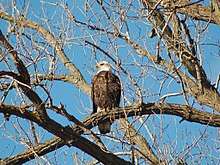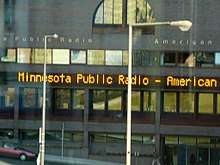Minneapolis–Saint Paul
Minneapolis–Saint Paul is a major metropolitan area built around the Mississippi, Minnesota and St. Croix rivers in east central Minnesota.[8] The area is commonly known as the Twin Cities after its two largest cities, Minneapolis, the most populous city in the state, and its neighbor to the east Saint Paul, the state capital. It is an example of twin cities in the sense of geographical proximity. Minnesotans living outside of Minneapolis and Saint Paul often refer to the two together (or the seven-county metro area collectively) simply as "the Cities."
Minneapolis–Saint Paul
| |
|---|---|
From top: Minneapolis, Saint Paul | |
| Country | United States |
| States | Minnesota and Wisconsin |
| Principal cities | Minneapolis, Saint Paul |
| Area | |
| • Urban | 1,021.8 sq mi (2,646 km2) |
| • Metro | 8,120 sq mi (21,000 km2) |
| Highest elevation | 1,376 ft (419 m) |
| Lowest elevation | 660 ft (200 m) |
| Population (2010) | |
| • Density | 2,594.3/sq mi (1,021.8/km2) |
| • Urban | 2,650,890 (16th) |
| • MSA | 3,654,908 (16th) |
| • CSA | 4,014,593 (16th) |
| |
| Time zone | UTC−6 (CST) |
| • Summer (DST) | UTC−5 (CDT) |
| MSA Historical Population | |||
|---|---|---|---|
| Census | Pop. | %± | |
| 1850 | 4,491 | — | |
| 1860 | 77,565 | 1,627.1% | |
| 1870 | 167,674 | 116.2% | |
| 1880 | 284,766 | 69.8% | |
| 1890 | 540,232 | 89.7% | |
| 1900 | 649,735 | 20.3% | |
| 1910 | 808,388 | 24.4% | |
| 1920 | 921,031 | 13.9% | |
| 1930 | 1,069,845 | 16.2% | |
| 1940 | 1,162,361 | 8.6% | |
| 1950 | 1,346,285 | 15.8% | |
| 1960 | 1,697,403 | 26.1% | |
| 1970 | 2,079,826 | 22.5% | |
| 1980 | 2,255,502 | 8.4% | |
| 1990 | 2,595,799 | 15.1% | |
| 2000 | 3,031,918 | 16.8% | |
| 2010 | 3,346,859 | 10.4% | |
| Est. 2019 | 3,654,908 | [1] | 9.2% |
| U.S. Decennial Census[2] 1790–1960[3] 1900–1990[4] 1990–2000[5] 2010–2018 | |||
| CSA Historical Population | |||
|---|---|---|---|
| Census | Pop. | %± | |
| 1850 | 4,909 | — | |
| 1860 | 100,503 | 1,947.3% | |
| 1870 | 227,182 | 126.0% | |
| 1880 | 374,208 | 64.7% | |
| 1890 | 651,160 | 74.0% | |
| 1900 | 780,923 | 19.9% | |
| 1910 | 943,975 | 20.9% | |
| 1920 | 1,070,395 | 13.4% | |
| 1930 | 1,228,835 | 14.8% | |
| 1940 | 1,330,771 | 8.3% | |
| 1950 | 1,523,428 | 14.5% | |
| 1960 | 1,891,459 | 24.2% | |
| 1970 | 2,300,115 | 21.6% | |
| 1980 | 2,503,343 | 8.8% | |
| 1990 | 2,866,678 | 14.5% | |
| 2000 | 3,335,000 | 16.3% | |
| 2010 | 3,682,928 | 10.4% | |
| Est. 2018 | 4,014,593 | [1] | 9.0% |
| U.S. Decennial Census[2] 1790–1960[3] 1900–1990[6] 1990–2000[7] 2010–2018 | |||
There are several different definitions of the region. Many refer to the Twin Cities as the seven-county region which is governed under the Metropolitan Council regional governmental agency and planning organization. The Office of Management and Budget officially designates 16 counties as the "Minneapolis–St. Paul–Bloomington MN–WI Metropolitan Statistical Area", the 16th largest in the United States. The entire region known as the "Minneapolis–St. Paul MN–WI Combined Statistical Area", has a population of 4,014,593, the 16th largest, according to 2018 Census estimates.
Despite the 'Twin' moniker, the cities are independent municipalities with defined borders. Minneapolis sits mostly on the west side of the Mississippi, and is somewhat more modern with a relatively young Downtown and trendy Uptown. Saint Paul, which sits mostly on the east side of the river, has been likened to an East Coast city, with quaint neighborhoods and a vast collection of well-preserved late-Victorian architecture.[9] The distinct urban cultures of the cities led an observer to note that "St. Paul is the last city of the East; Minneapolis the first city of the West."[10]
Minneapolis was influenced by its early Scandinavian and Lutheran heritage, while Saint Paul was influenced by its early French, Irish and German Catholic roots.
History

The first European settlement in the region was near what is now known as the town of Stillwater, Minnesota. The city is approximately 20 miles (30 km) from downtown Saint Paul and lies on the western bank of the St. Croix River, which forms the border of central Minnesota and Wisconsin. Another settlement that began fueling early interest in the area was the outpost at Fort Snelling, which was constructed from 1820 to 1825 at the confluence of the Minnesota River and the Mississippi River.[11]
Fort Snelling held jurisdiction over the land south of Saint Anthony Falls, thus a town known as Saint Anthony grew just north of the river. For several years, the only European resident to live on the south bank of the river was Colonel John H. Stevens, who operated a ferry service across the river. As soon as the land area controlled by Fort Snelling was reduced, new settlers began flocking across to the new village of Minneapolis. The town grew quickly, and Minneapolis and Saint Anthony eventually merged.[12] On the eastern side of the Mississippi, a few villages such as Pig's Eye and Lambert's Landing developed and would soon grow to become Saint Paul.[13]
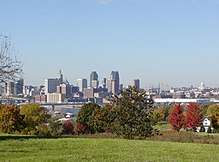
Natural geography played a role in the settlement and development of the two cities. The Mississippi River Valley in this area is defined by a series of stone bluffs that line both sides of the river. Saint Paul grew up around Lambert's Landing, the last place to unload boats coming upriver at an easily accessible point, some seven miles (11 km) downstream from Saint Anthony Falls, the geographic feature that, due to the value of its immense water power for industry, defined the location of Minneapolis and its prominence as the Mill City. The falls can be seen today from the Mill City Museum, housed in the former Washburn "A" Mill, which was among the world's largest mills in its time.
The oldest farms in the state are located in Washington County, the easternmost county on the Minnesota side of the metropolitan area. Joseph Haskell was Minnesota's first farmer, harvesting the first crops in the state in 1840 on what is now part of Afton Township on Trading Post Trail.[14]
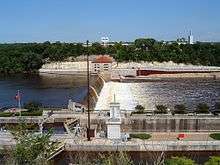
The Grand Excursion, a trip into the Upper Midwest sponsored by the Rock Island Railroad, brought more than a thousand curious travelers into the area by rail and steamboat in 1854. The next year, in 1855, Henry Wadsworth Longfellow published The Song of Hiawatha, an epic poem based on the Ojibwe legends of Hiawatha. A number of natural area landmarks were included in the story, such as Lake Minnetonka and Minnehaha Falls. Tourists inspired by the coverage of the Grand Excursion in eastern newspapers and those who read Longfellow's story flocked to the area in the following decades.
At one time, the region also had numerous passenger rail services, including both interurban streetcar systems and interstate rail. Due to the width of the river at points further south, the Minneapolis–Saint Paul area was briefly one of the few places where the Mississippi could be crossed by railroad. A great amount of commercial rail traffic also ran through the area, often carrying grain to be processed at mills in Minneapolis or delivering other goods to Saint Paul to be transported along the Mississippi. Saint Paul had long been at the head of navigation on the river, prior to a new lock and dam facility being added upriver in Minneapolis.
Passenger travel hit its peak in 1888 with nearly eight million traversing to and from the Saint Paul Union Depot. This amounted to approximately 150 trains daily. Before long, other rail crossings were built farther south and travel through the region began to decline. In an effort by the rail companies to combat the rise of the automobile, some of the earliest streamliners ran from Chicago to Minneapolis/Saint Paul and eventually served distant points in the Pacific Northwest. Today, the only vestige of this interstate service comes by Amtrak's Seattle/Portland to Chicago Empire Builder route, running once daily in each direction. It is named after James J. Hill, a railroad tycoon who settled on Summit Avenue in Saint Paul at what is now known as the James J. Hill House.
Like many Northern cities that grew up with the Industrial Revolution, Minneapolis and St. Paul experienced shifts in their economic base as heavy industry declined, especially in the 1960s and 1970s. Along with the economic decline of the 60s and 70s came population decline in the central city areas, white flight to suburbs,[15] and, in the summer of 1967, race riots on Minneapolis's North Side.[16] By the 1980s and 1990s, however, Minneapolis and Saint Paul were frequently cited as former Rust Belt cities that had made successful transitions to service, high-technology, finance, and information economies.[17]
In May and June 2020, the Minneapolis–Saint Paul metropolitan area became a focus of international attention as a MPD officer Derek Chauvin killed George Floyd by kneeling on his neck for almost nine minutes. The killing sparked local, nationwide and international protests against racism and police brutality, bringing considerable spotlight on the MPD.[18] Bob Kroll, head of the MPD union, characterized Floyd as a "violent criminal" and called the protests a "terrorist movement".[19] In June 2020, Minneapolis City Council President Lisa Bender announced that the city should dismantle its police department and replace it with a "transformative new model of public safety."[20]
Rivalry
Minneapolis and Saint Paul have competed since they were founded, resulting in some duplication of effort.[21] After Saint Paul completed its elaborate Cathedral in 1915, Minneapolis quickly followed up with the equally ornate Basilica of St. Mary in 1926. In the late 19th and early 20th centuries the rivalry became so intense that an architect practicing in one city was often refused business in the other. The 1890 United States Census even led to the two cities arresting and/or kidnapping each other's census takers, in an attempt to keep either city from outgrowing the other.[22][23][24]
The rivalry could occasionally erupt into inter-city violence, as happened at a 1923 game between the Minneapolis Millers and the St. Paul Saints, both baseball teams of the American Association. In the 1950s, both cities competed for a major league baseball franchise (which resulted in two rival stadiums being built), and there was a brief period in the mid-1960s where the two cities could not agree on a common calendar for daylight saving time, resulting in a period of a few weeks where people in Minneapolis were one hour "behind" anyone living or traveling in Saint Paul.[25]
The cities' mutual antagonism was largely healed by the end of the 1960s, aided by the simultaneous arrival in 1961 of the Minnesota Twins of the American League and the Minnesota Vikings of the National Football League, both of which identified themselves with the state as a whole (the former explicitly named for both Twin Cities) and not with either of the major cities (unlike the earlier Minneapolis Lakers). Since 1961, it has been common practice for any major sports team based in the Twin Cities to be named for Minnesota as a whole. In terms of development, the two cities remain distinct in their progress, with Minneapolis absorbing new and avant-garde architecture while Saint Paul continues to carefully integrate new buildings into the context of classical and Victorian styles.[21]
Geography and geology
Along with much of Minnesota, the Twin Cities area was shaped by water and ice over the course of millions of years. The land of the area sits on top of thick layers of sandstone and limestone laid down as seas encroached upon and receded from the region. Erosion caused natural caves to develop, which were expanded into mines when white settlers came to the area. In the time of Prohibition, at least one speakeasy was built into these hidden spaces—eventually refurbished as the Wabasha Street Caves in Saint Paul.
Lakes across the area were formed and altered by the movement of glaciers. This left many bodies of water in the region, and unusual shapes may appear. For example, Lake Minnetonka out toward the western side of the Twin Cities consists of a complex arrangement of channels and large bays. Elevations in the metropolitan area range from 1,376 feet (419 m) above sea level in the northwest metro to 666 feet (203 m) at the edge of the Mississippi River in the southeast.
Because it is comparatively easy to dig through limestone and there are many natural and man-made open spaces, it has often been proposed that the area should examine the idea of building subways for public transportation. In theory, it could be less expensive in the Twin Cities than in many other places, but the cost would still be much greater than surface projects.
Climate
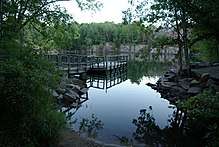
Owing to its northerly latitude and inland location, the Twin Cities experience the coldest climate of any major metropolitan area in the United States.[26] However, due to its southern location in the state and aided further by the urban heat island, the Twin Cities is one of the warmest locations in Minnesota.[27] The average annual temperature at the Minneapolis–Saint Paul International Airport is 45.4 °F (7.4 °C); 3.5 °F (1.9 °C) colder than Winona, Minnesota, and 8.8 °F (4.9 °C) warmer than Roseau, Minnesota.[28] Monthly average daily high temperatures range from 21.9 °F (−5.6 °C) in January to 83.3 °F (28.5 °C) in July; the average daily minimum temperatures for the two months are 4.3 °F (−15.4 °C) and 63.0 °F (17.2 °C) respectively.[29]

Minimum temperatures of 0 °F (−18 °C) or lower are seen on an average of 29.7 days per year, and 76.2 days do not have a maximum temperature exceeding the freezing point. Temperatures above 90 °F (32 °C) occur an average of 15 times per year. High temperatures above 100 °F (38 °C) have been common in recent years; the last occurrence was on July 6, 2012. The lowest temperature ever reported at the Minneapolis–Saint Paul International Airport was −34 °F (−37 °C) on January 22, 1936; the highest, 108 °F (42 °C), was reported on July 14 of the same year.[30] Early settlement records at Fort Snelling show temperatures as low as −42 °F (−41 °C). Recent records include −40 °F (−40 °C) at Vadnais Lake on February 2, 1996 (National Climatic Data Center)
Precipitation averages 29.41 inches (74.7 cm) per year, and is most plentiful in June (4.34 inches (11.0 cm)) and February (0.79 inches (2.0 cm)) the least so. The greatest one-day rainfall amount was 9.15 inches (23.2 cm), reported on July 23, 1987. The city's record for lowest annual precipitation was set in 1910, when 11.54 inches (29.3 cm) fell throughout the year; coincidentally, the opposite record was set the following year, which observed a total 40.15 inches (1,020 mm).[31] At an average of 56.3 inches (1,430 mm) per year, snowfall is generally abundant.[32]
The Twin Cities area takes the brunt of many types of extreme weather, including high-speed straight-line winds, tornadoes, flash floods, drought, heat, bitter cold, and blizzards. The costliest weather disaster in Twin Cities history was a derecho event on May 15, 1998. Hail and Wind damage exceeded $950 million, much of it in the Twin Cities.[33] Other memorable Twin Cities weather-related events include the tornado outbreak on May 6, 1965, the Armistice Day Blizzard on November 11, 1940, and the Halloween Blizzard of 1991. In 2019, Minnesota experienced its coldest temperatures since 1996, when a polar vortex dropped temperatures as low as −56 °F (−49 °C) in Cotton, MN with windchills lower than −60 °F (−51 °C) in much of the state. These temperatures are colder than those found on the surface of Mars. (See: Department of Natural Resources - Cold Outbreak: January 27-31, 2019)
A normal growing season in the metro extends from late April or early May through the month of October.[34] The USDA places the area in the 4a plant hardiness zone.[35]
Buildings and structures
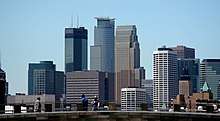
The four tallest buildings in the area are located in downtown Minneapolis. Today there is some contention over exactly which building is the tallest—most Minnesotans would immediately think of the IDS Center if queried on the point, although most sources seem to agree that Capella Tower is slightly taller. But in early 2005, it was found that the IDS Center is taller by a 16-foot (5 m) washroom garage on top, which brings its total height to 792 feet (241 m). Capella Tower and the Wells Fargo Center only differ in height by a foot or two, a rather negligible amount.
Buildings have gone up and been torn down rapidly across the region. Some city blocks have been demolished six or seven times since the mid-19th century, and will undoubtedly reach an eighth or ninth cycle in short order.[36] No single architectural style dominates the region. Instead, the cities have a mish-mash of different designs, although structures from a few eras stand out. There were once a great many stone buildings constructed in the Richardsonian Romanesque style (or at least Romanesque-inspired variants). Minneapolis City Hall is one prominent example of this, though buildings of all types—including personal residences such as the James J. Hill House—were similarly designed.[37] A few decades later, Art Deco brought several structures that survive today, including St. Paul City Hall, the Foshay Tower, and the Minneapolis Post Office. The style of buildings in the two cities varies greatly. In Minneapolis, the trend has been buildings with sleek lines and modern glass facades while Saint Paul tends to follow a more traditional style of buildings so as to better accompany its older structures.
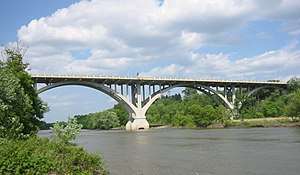
Saint Paul and Minneapolis in particular went through some massive urban renewal projects in the post-World War II era, so a vast number of buildings are now lost to history. Some of the larger and harder to demolish structures have survived.[36] In fact, the area might be signified more by bridges than buildings. A series of reinforced concrete arch spans crossing the Mississippi River were built in the 1920s and 1930s. They still carry daily traffic, but remain pleasing to the eye despite their age (a number have undergone major repair work, but retain the original design). Several of the bridges are listed on the National Register of Historic Places. They include the 10th Avenue Bridge, Intercity Bridge (Ford Parkway), Robert Street Bridge, and the longest, the 4,119 ft (1,255 m) Mendota Bridge next to Fort Snelling. The area is also noted for having the first known permanent crossing of the Mississippi. That structure is long gone, but a series of Hennepin Avenue Bridges have been built since then at the site. Both downtowns have extensive networks of enclosed pedestrian bridges known as skyways.

Several prominent buildings in Minneapolis have helped modernize the city. These include the Walker Art Center, Central Public Library, Weisman Art Museum and the Guthrie Theater. Opening in April 2005, the new Walker Art Center, nearly double in size, includes increased indoor and outdoor facilities. The Walker is recognized internationally as a singular model of a multidisciplinary arts organization and as a national leader for its innovative approaches to audience engagement. The Guthrie received a large amount of media coverage for its opening in June 2006. The design is the work of architect Jean Nouvel and is a 285,000 square feet (26,500 m2) facility that houses three theaters: the theater's signature thrust stage, seating 1,100; a 700-seat proscenium stage; and a black-box studio with flexible seating. In 2002, the National Trust for Historic Preservation put the old Guthrie building on its list of the most endangered historic properties in the United States in response to plans announced by the Walker Art Center to expand on the land occupied by the theater. However, the original Guthrie building was torn down in 2006. These building projects have rejuvenated the downtown area.
Communities
MSA
The Minneapolis–Saint Paul metropolitan area, or Twin Cities, includes 16 counties, of which 14 are in Minnesota and two in Wisconsin. The Minnesota portion accounts for almost two-thirds of Minnesota's population.
Note: Counties that are bolded are under jurisdiction of the Metropolitan Council. Counties that are italicized were added to the metropolitan area when the Office of Management and Budget revised its delineations of metropolitan statistical areas in 2013.[38][39]
Minneapolis–St. Paul–Bloomington MN–WI Metropolitan Statistical Area
| County | Seat | 2018 Estimate | 2010 Census | Change | Area | Density |
|---|---|---|---|---|---|---|
| Hennepin | Minneapolis | 1,262,003 | 1,152,425 | +9.51% | 607 sq mi (1,570 km2) | 2,079/sq mi (803/km2) |
| Ramsey | Saint Paul | 552,232 | 508,640 | +8.57% | 170 sq mi (440 km2) | 3,248/sq mi (1,254/km2) |
| Dakota | Hastings | 428,484 | 398,552 | +7.51% | 587 sq mi (1,520 km2) | 730/sq mi (282/km2) |
| Anoka | Anoka | 357,851 | 330,884 | +8.15% | 446 sq mi (1,160 km2) | 802/sq mi (310/km2) |
| Washington | Stillwater | 261,517 | 238,136 | +9.82% | 423 sq mi (1,100 km2) | 618/sq mi (239/km2) |
| Scott | Shakopee | 146,111 | 129,928 | +12.46% | 365 sq mi (950 km2) | 400/sq mi (155/km2) |
| Wright | Buffalo | 131,078 | 124,700 | +5.11% | 714 sq mi (1,850 km2) | 184/sq mi (71/km2) |
| Carver | Chaska | 105,837 | 91,042 | +16.25% | 376 sq mi (970 km2) | 281/sq mi (109/km2) |
| Sherburne | Elk River | 91,126 | 88,499 | +2.97% | 451 sq mi (1,170 km2) | 180/sq mi (69/km2) |
| St. Croix, WI | Hudson | 89,694 | 84,345 | +6.34% | 736 sq mi (1,910 km2) | 122/sq mi (47/km2) |
| Chisago | Center City | 54,025 | 53,887 | +0.26% | 442 sq mi (1,140 km2) | 122/sq mi (47/km2) |
| Pierce, WI | Ellsworth | 42,784 | 41,019 | +4.30% | 592 sq mi (1,530 km2) | 72/sq mi (28/km2) |
| Isanti | Cambridge | 38,413 | 37,816 | +1.58% | 452 sq mi (1,170 km2) | 85/sq mi (33/km2) |
| Le Sueur | Le Center | 27,770 | 27,703 | +0.24% | 449 sq mi (1,160 km2) | 62/sq mi (24/km2) |
| Mille Lacs | Milaca | 25,884 | 26,097 | −0.82% | 682 sq mi (1,770 km2) | 38/sq mi (15/km2) |
| Sibley | Gaylord | 14,918 | 15,226 | −2.02% | 601 sq mi (1,560 km2) | 25/sq mi (10/km2) |
| Total | 3,629,190 | 3,346,859 | +8.44% | 8,093 sq mi (20,960 km2) | 448/sq mi (173/km2) |
CSA
The Minneapolis–St. Paul, MN–WI Combined Statistical Area is made up of 20 counties in Minnesota and two counties in Wisconsin. The statistical area includes two metropolitan areas and four micropolitan areas. As of the 2010 Census, the CSA had a population of 3,682,928 (though a July 1, 2012 estimate placed the population at 3,691,918). In 2013, Owatonna, MN Micropolitan Statistical Area was added.[40] The CSA definition encompasses 12,130 sq mi (31,400 km2) of area.
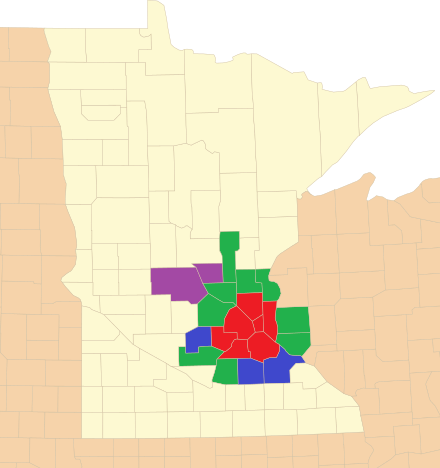
Minneapolis–St. Paul, MN–WI Combined Statistical Area
| Statistical Area | 2018 Estimate | 2010 Census | Change | Area | Density |
|---|---|---|---|---|---|
| Minneapolis–St. Paul–Bloomington MN–WI Metropolitan Statistical Area | 3,629,190 | 3,346,859 | +8.44% | 8,093 sq mi (20,960 km2) | 448/sq mi (173/km2) |
| St. Cloud, MN Metropolitan Statistical Area (Stearns and Benton counties) | 199,801 | 189,093 | +5.66% | 1,803 sq mi (4,670 km2) | 111/sq mi (43/km2) |
| Hutchinson, MN Micropolitan Statistical Area (McLeod County) | 35,873 | 36,651 | −2.12% | 506 sq mi (1,310 km2) | 71/sq mi (27/km2) |
| Faribault-Northfield, MN Micropolitan Statistical Area (Rice County) | 66,523 | 64,142 | +3.71% | 516 sq mi (1,340 km2) | 129/sq mi (50/km2) |
| Red Wing, MN Micropolitan Statistical Area (Goodhue County) | 46,403 | 46,183 | +0.48% | 780 sq mi (2,000 km2) | 59/sq mi (23/km2) |
| Owatonna, MN Micropolitan Statistical Area (Steele County) | 36,803 | 36,575 | +0.62% | 432 sq mi (1,120 km2) | 85/sq mi (33/km2) |
| Total | 4,014,593 | 3,719,503 | +7.93% | 12,130 sq mi (31,400 km2) | 331/sq mi (128/km2) |
Note: Owatonna MSA was not part of CSA in 2010.
Cities and suburbs
There are approximately 218 incorporated municipalities within the Twin Cities metropolitan region. This includes census-designated places along with villages in Wisconsin, but excludes unincorporated towns in Wisconsin, known as civil townships in other states. Estimates are as of 2018 for cities with 25,000 or more inhabitants and 2020 for cities with 50,000 or more inhabitants.[41]
Principal cities (2018 / 2020 estimates)[42]
- Minneapolis (437,069)
- Saint Paul (311,895)
Places with 50,000 to 99,999 inhabitants
- Bloomington (85,818)
- Brooklyn Park (81,486)
- Plymouth (81,014)
- Maple Grove (74,063)
- Woodbury (73,404)
- Lakeville (69,295)
- Blaine (67,496)
- Eagan (67,097)
- Eden Prairie (64,704)
- Coon Rapids (62,795)
- Burnsville (61,461)
- Apple Valley (55,059)
- Minnetonka (54,861)
- Edina (53,186)
Places with 25,000 to 49,999 inhabitants
- St. Louis Park (48,910)
- Shakopee (41,506)
- Maplewood (40,710)
- Cottage Grove (37,341)
- Richfield (36,436)
- Roseville (36,272)
- Inver Grove Heights (35,381)
- Andover (32,728)
- Brooklyn Center (32,299)
- Savage (31,407)
- Fridley (28,824)
- Oakdale (28,315)
- Chaska (27,622)
- Ramsey (27,051)
- Shoreview (26,480)
- Chanhassen (26,266)
- Prior Lake (26,135)
- White Bear Lake (25,071)
Places with 10,000 to 24,999 inhabitants
- Rosemount (24,342)
- Elk River (23,963)
- Champlin (23,927)
- Crystal (22,943)
- Farmington (22,731)
- Hastings (22,554)
- New Brighton (22,351)
- Golden Valley (21,270)
- Lino Lakes (21,050)
- New Hope (21,032)
- South St. Paul (20,405)
- Columbia Heights (19,815)
- West St. Paul (19,727)
- Forest Lake (19,618)
- Stillwater (18,924)
- Hopkins (18,076)
- St. Michael (17,596)
- Anoka (17,350)
- Buffalo (16,806)
- Ham Lake (16,062)
- Otsego (15,551)
- River Falls, Wisconsin (15,339)
- Robbinsdale (14,418)
- Hugo (14,388)
- Hudson, Wisconsin (13,566)
- Monticello (13,459)
- Vadnais Heights (13,266)
- Mounds View (12,914)
- Rogers (12,562)
- North St. Paul (12,322)
- Waconia (11,968)
- East Bethel (11,692)
- Mendota Heights (11,223)
- Big Lake (10,868)
- Little Canada (10,319)
- North Branch (10,215)
Places with fewer than 10,000 inhabitants
- Arden Hills (9,951)
- Mound (9,336)
- St. Anthony (8,991)
- Victoria (8,676)
- Cambridge (8,451)
- Oak Grove (8,439)
- Lake Elmo (8,406)
- Mahtomedi (8,116)
- Orono (8,006)
- Wyoming (7,813)
- Albertville (7,745)
- Shorewood (7,614)
- New Prague (7,582)
- Saint Francis (7,406)
- Minnetrista (7,178)
- Belle Plaine (6,918)
- Spring Lake Park (6,473)
- Delano (6,280)
- Jordan (6,076)
- Medina (5,973)
- Falcon Heights (5,571)
- Corcoran (5,552)
- Isanti (5,464)
- Saint Paul Park (5,379)
- Zimmerman (5,350)
- Dayton (5,096)
- North Oaks (4,968)
- Circle Pines (4,958)
- Chisago City (4,932)
- Oak Park Heights (4,831)
- Elko New Market (4,705)
- Becker (4,700)
- Princeton (4,680)
- Wayzata (4,610)
- Nowthen (4,582)
- Rockford (4,439)
- Lindstrom (4,401)
- Carver (4,311)
- Watertown (4,289)
- Prescott, Wisconsin (4,258)
- Grant (4,147)
- Scandia (4,057)
- Columbus (4,007)
- Le Sueur (3,999)
- Centerville (3,930)
- Deephaven (3,843)
- Independence (3,741)
- Bayport (3,714)
- Norwood Young America (3,677)
- Newport (3,480)
- Hanover (3,449)
- Annandale (3,332)
- Montrose (3,119)
- Rush City (3,072)
- Afton (2,966)
- Greenfield (2,919)
- Montgomery (2,915)
- Milaca (2,883)
- Cokato (2,785)
- Osseo (2,748)
- Lauderdale (2,506)
- Le Center (2,459)
- St. Bonifacius (2,320)
- Excelsior (2,279)
- Maple Lake (2,268)
- Gaylord (2,245)
- Arlington (2,169)
- Howard Lake (2,157)
- Lexington (2,022)
- Mayer (1,903)
- Clearwater (1,855)
- Waterville (1,849)
- Lakeland (1,839)
- Long Lake (1,800)
- Maple Plain (1,785)
- Braham (1,770)
- Spring Park (1,705)
- Cologne (1,605)
- Waverly (1,588)
- Tonka Bay (1,537)
- Stacy (1,470)
- Winthrop (1,363)
- Harris (1,125)
- Dellwood (1,094)
- Lake St. Croix Beach (1,075)
- Shafer (1,036)
- Taylors Falls (1,014)
- Birchwood Village (878)
- Henderson (874)
- Lilydale (872)
- Gibbon (752)
- Hilltop (736)
- Landfall (735)
- Greenwood (718)
- Cleveland (700)
- Marine on St. Croix (695)
- Hampton (687)
- Elysian (669)
- Loretto (668)
- Kasota (660)
- Clear Lake (645)
- Center City (628)
- Minnetonka Beach (570)
- Sunfish Lake (538)
- Green Isle (537)
- Hamburg (520)
- Foreston (516)
- Willernie (496)
- Bethel (472)
- Gem Lake (469)
- Woodland (463)
- Randolph (441)
- New Auburn (437)
- Vermillion (424)
- Pine Springs (396)
- New Germany (389)
- St. Marys Point (380)
- Medicine Lake (374)
- Lakeland Shores (314)
- Pease (240)
- Wahkon (209)
- Mendota (205)
- South Haven (192)
- Coates (163)
- Kilkenny (133)
- Miesville (131)
- Heidelberg (123)
- New Trier (113)
- Bock (105)
Culture
Fine and performing arts
The Minneapolis–Saint Paul metropolitan area fine art museums include the Minneapolis Institute of Art, the Walker Art Center, the Frederick R. Weisman Art Museum, Minnesota Museum of American Art and The Museum of Russian Art. The Minnesota Orchestra and the Saint Paul Chamber Orchestra are full-time professional musical ensembles. The Guthrie Theater moved into a new building in 2006 overlooking the Mississippi River. The Minnesota Fringe Festival is an annual celebration of theatre, dance, improvisation, puppetry, kids' shows, visual art, and musicals.[43]
The Twin Cities is also the home of Minnesota Public Radio (MPR), the second largest public radio station in the country. It hosts both a classical station and a contemporary station, The Current, which plays music from regional and other contemporary artists. The MPR program A Prairie Home Companion, hosted by Minnesota native Garrison Keillor aired live for many years from the Fitzgerald Theater in Saint Paul. The show ended its run in 2016, with its successor Live from Here also airing from the same venue. This radio program was the basis of the 2006 film of the same name, A Prairie Home Companion.
The Current and the Walker Art Center also host an annual music festival Rock the Garden, which features nationally recognized and local artists. The festival has been annually presented since 2008 and has featured artists such as Lizzo, Hippo Campus, Chance the Rapper, Bon Iver, The Flaming Lips, Wilco and Sonic Youth.[44]
The Basilica of Saint Mary in the city of Minneapolis also hosts the annual Basilica Block Party, another annual music festival which brings in nationally recognized artists such as Weezer, Andy Grammer, Deathcab for Cutie and Panic! at the Disco. The festival is used as a fundraiser for the restoration of the basilica.[45] The event draws approximately 25,000 people to the downtown area.
Aside from the music festivals that take place in the region, the Twin Cities area is also home to a number of venues where artists come to perform. Minneapolis is home to the famous First Avenue. First Avenue is known for being the starting venue for many famous artists and bands that have come from the area including Prince, The Replacements, Atmosphere, Manny Phesto and others. It became one of the most recognizable venues in Minnesota following the release of the Prince movie Purple Rain, in which the venue is featured.
Outdoors
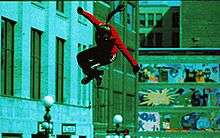
There are numerous lakes in the region, and cities in the area have some very extensive park systems for recreation. Organized recreation includes the Great River Energy bicycle festival, the Twin Cities Marathon, and the U.S. pond hockey championships. Some studies have shown that area residents take advantage of this, and are among the most physically fit in the country, though others have disputed that. Nonetheless, medicine is a major industry in the region and the southeasterly city of Rochester, as the University of Minnesota has joined other colleges and hospitals in doing significant research, and major medical device manufacturers started in the region (the most prominent is Medtronic). Technical innovators have brought important advances in computing, including the Cray line of supercomputers.
It is common for residents of the Twin Cities area to own or share cabins and other properties along lakes and forested areas in the central and northern regions of the state, and weekend trips "up North" happen through the warmer months. Ice fishing is also a major pastime in the winter, although each year some overambitious fishermen find themselves in dangerous situations when they venture out onto the ice too early or too late. Hunting, snowmobiling, ATV riding and numerous other outdoor activities are also popular. This connectedness with the outdoors also brings a strong sense of environmentalism to many Minnesotans.
In 2011 and 2012, the American College of Sports Medicine named Minneapolis–Saint Paul the healthiest metropolitan area in America.[46][47]
Sports

The Twin Cities is one of thirteen American metropolitan areas to have teams in all four major professional sports — Baseball (MLB), Football (NFL), Basketball (NBA) and Ice Hockey (NHL). Including Major League Soccer (MLS), it is one of eleven metro areas to have five major sports. To avoid favoring either of the Twin Cities, most teams based in the area use only the word Minnesota in their name, rather than Minneapolis or Saint Paul.
Minneapolis was the site of two Super Bowls – Super Bowl XXVI in 1992 and Super Bowl LII in 2018. It was the farthest north that a Super Bowl has ever been played. Minnesota has played in four Super Bowls - IV in 1970, VIII in 1974, IX in 1975 and XI in 1977.
The World Series has been played in the Twin Cities three times – 1965, 1987 and 1991 – as well as three Major League Baseball All-Star Games – 1965, 1985 and 2014. All-Star games in the National Hockey League were hosted in 1972 and 2004, the National Basketball Association in 1994 and the Women's National Basketball Association in 2018.
The Stanley Cup Finals have been played in the Twin Cities twice – 1981 and 1991 – as well as the NHL Stadium Series played host to a game in 2016.
The Final Four Men's National College Athletics Association (NCAA) basketball tournament has been hosted by Minneapolis four times – 1951, 1992, 2001 and 2019 – and Women's one time – 1995. The women's tournament will return to Minneapolis in 2022.
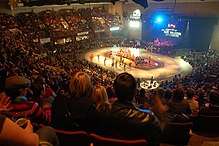
Major golf tournaments hosted in the Twin Cities include: US Open – 1916, 1930, 1970, 1991; US Women's Open – 1966, 1977, 2008; PGA Championship – 1932, 1954, 2002, 2009; Women's PGA Championship - 2019; Walker Cup – 1957; Solheim Cup – 2002 and the Ryder Cup – 2016. The Ryder Cup is scheduled to return in 2028.
The 1998 World Figure Skating Championships was held at Target Center in Minneapolis.
The 2017, 2018 and 2019 X Games were held in Minneapolis. The 2020 X Games was cancelled on April 25 due to the ongoing coronavirus pandemic.
The Twin Cities host three nationally competing Roller Derby leagues: The Minnesota Roller Derby of the Women's Flat Track Derby Association Division 1, the North Star Roller Derby of WFTDA Division 2, and Minnesota Men's Roller Derby, a league of the Men's Roller Derby Association. MNRD and NSRD possess four home teams each: the Dagger Dolls, Garda Belts, Rockits, and Atomic Bombshells of MNRD and the Banger Sisters, Delta Delta Di, Kilmores, and Violent Femmes of NSRD, as well as two traveling teams each. MMRD possesses three home teams: The Gentlemen's Club, Destruction Workers, and Thunderjacks, and two traveling teams.
The annual Twin Cities Marathon is held in the fall with a course running through Minneapolis and Saint Paul. Minneapolis was the birthplace of Rollerblade and is a center for inline skating, as well as home to the most golfers per capita of any city in the U.S.[48] Additionally, water skiing got its start on Lake Pepin, a lake southeast of the metropolitan area, located in the Mississippi River about 50 miles (80 km) downstream from Saint Paul.[49]
Some other sports teams gained their names from being in Minnesota before relocating. The Los Angeles Lakers get their name from once being based in Minneapolis, the City of Lakes. The Dallas Stars also derived their present name from their tenure as a Minnesota team, the Minnesota North Stars.
Professional sports teams in Minneapolis–Saint Paul
| Club | Sport | League | Venue | City | Since | Titles |
|---|---|---|---|---|---|---|
| Minnesota Twins | Baseball | American League, Major League Baseball | Target Field | Minneapolis | 1961 | 1987, 1991 |
| St. Paul Saints | Baseball | AAIPB | CHS Field | St. Paul | 1993 | 2019 1993, 1995, 1996, and 2004 (NL) |
| Minnesota Vikings | American football | National Football League | U.S. Bank Stadium | Minneapolis | 1961 | 1969 (Not Super Bowl) |
| Minnesota Vixen | American football | Women's Football Alliance | Simley Athletic Field | Inver Grove Heights | 1999 | |
| Minnesota Timberwolves | Basketball | National Basketball Association | Target Center | Minneapolis | 1989 | |
| Minnesota Lynx | Basketball | Women's National Basketball Association | Target Center | Minneapolis | 1999 | 2011, 2013, 2015, 2017 |
| Minnesota Wild | Ice hockey | National Hockey League | Xcel Energy Center | St. Paul | 2000 | |
| Minnesota Whitecaps | Ice hockey | National Women's Hockey League | TRIA Rink | St. Paul | 2004 | 2010 (Clarkson Cup), 2019 (Isobel Cup) |
| Minnesota United FC | Soccer | Major League Soccer | Allianz Field | St. Paul | 2015 | 2011 (NASL) |
Media
Print
The Twin Cities have two major daily newspapers: the Star Tribune and the Saint Paul Pioneer Press. Additionally, the Minnesota Daily serves the University of Minnesota's Twin Cities campus and surrounding neighborhoods. There is one general-interest neighborhood weekly newspaper still in the cities: The East Side Review, devoted to the 90,000 residents in the eastern third of Saint Paul. Other weekly papers are devoted to specific audiences/demographics including City Pages.
Television
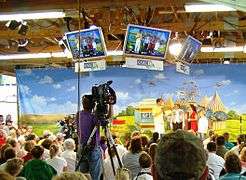
The region is currently ranked as the 15th largest television market according to Nielson Media Research. Three duopolies exist in the Twin Cities: Twin Cities PBS operates both KTCA and KTCI, Hubbard Broadcasting (built by Stanley E. Hubbard) owns both ABC affiliate KSTP-TV and independent station KSTC-TV, and Fox Television Stations operates both Fox owned-and-operated station KMSP-TV and MyNetworkTV O&O WFTC. Diversified from radio, KSTP-TV became the first television channel to air in the region with a show reaching 3,000 television sets in 1948, and the 17th station to broadcast in the U.S.[50]

The only station with its main studios in Minneapolis is CBS O&O WCCO, while Saint Paul is host to KSTP/KSTC, KTCA/KTCI, and CW affiliate WUCW. NBC affiliate KARE has a sprawling broadcasting complex in west suburban Golden Valley. KMSP is located in southwest suburban Eden Prairie. Other stations are located in the suburbs. For much of the last two decades, WCCO and KARE have shared in having the most popular evening newscasts of the area channels. On the other end, KSTP has struggled to maintain ratings on its news programs. KMSP has had a 9 o'clock newscast since at least the early 1990s when it was an independent channel.
Communities in the region have their own Public, educational, and government access (PEG) cable television channels. One channel, the Metro Cable Network, is available on channel 6 on cable systems across the seven-county region.
Several television programs originating in the Twin Cities have been aired nationally on terrestrial and cable TV networks. KTCA created the science program Newton's Apple and distributes a children's program today. A few unusual comedic shows also originated in the area. In the 1980s, KTMA (predecessor to WUCW) created a number of low-budget shows, including cult classic Mystery Science Theater 3000. The short-lived Let's Bowl started on KARE, and PBS series Mental Engineering originated on the Saint Paul cable access network.
Radio
The radio market in the Twin Cities is ranked 15th by Nielsen in 2018, similar to its TV market size.[51][52] In November 2018, the top five morning radio shows in the area were all FM stations: KSTP, KXFN, KQQL, KDWB, and KXXR.[53] Three of the top five morning radio stations are owned by iHeartRadio. Most radio stations broadcast on air, and can be heard as well over the internet, as live streams from the web site of each radio station.
KSTP, a television station, also has radio stations, with pop music format on FM and ESPN Radio on AM. KSTP-AM and FM are owned by Hubbard Broadcasting. In 1985, Hubbard – valued at $400 million – was one of the larger corporate media companies in the United States; in 2005, valued at US$1.2 billion, Hubbard is a fairly small major-market media operation.
The Twin Cities have a mix of commercial and non-commercial radio stations. The city's market is dominated by iHeartRadio which operates seven stations. Two small, independent stations are award winners — KUOM operated by the University of Minnesota and KFAI public access radio in Cedar Riverside.[54]
Minnesota Public Radio (MPR) airs on KNOW 91.1 FM, KSJN 91.5 FM and KCMP 89.3 FM, with separate programs on each station. It is a major player in the state and across the country, first known across the U.S. for the variety show A Prairie Home Companion, which ceased production in 2016.[55] Doing business under the name American Public Media, the company is the second largest producer of National Public Radio content, behind National Public Radio (of which MPR is an affiliate). KCMP is also known as The Current.
Independent media
The Twin Cities is also home to many independent media organizations, including The UpTake, MinnPost and Twin Cities Daily Planet.
Demographics
Place of birth
Approximately 93.2% of the metropolitan area's population was native to the United States. Approximately 92.6% were born in the U.S. while 0.6% were born in Puerto Rico, a U.S. territory, or born abroad to American parents. The rest of the population (6.8%) were foreign-born.
The highest percentages of immigrants came from Asia (38.2%), Latin America (25.4%), and Africa (20.1%); smaller percentages of newcomers came from Europe (13.1%), other parts of North America (3.0%), and Oceania (0.2%).
With regards to ethnicity, the metropolitan area is predominantly white, with every county having at least 70% of its population coming from that background. However, the area is gradually becoming more diverse over time.
Religion

Minneapolis–Saint Paul is also a major center for religion in the state, especially Christianity. The state headquarters of five major Christian churches are found here: the Roman Catholic Archdiocese of Saint Paul and Minneapolis, the Episcopal Diocese of Minnesota, the Presbyterian Synod of Lakes and Prairies, and The Church of Jesus Christ of Latter-day Saints (LDS Church). The Presbyterian and LDS churches both have missions in Saint Paul, Minneapolis, and Bloomington as well as the Orthodox Church in America.
The headquarters of the former American Lutheran Church (ALC), Evangelical Lutheran Church, Lutheran Free Church and the Augustana Evangelical Lutheran Church were located in Minneapolis; the headquarters of Augsburg Fortress publishing house still is. The Minneapolis Area Synod and the Saint Paul Area Synod are the first and third largest synods of the Evangelical Lutheran Church in America (ELCA), respectively.
The Evangelical Free Church of America has its headquarters in Bloomington, and the Association of Free Lutheran Congregations is headquartered in Plymouth, along with its seminary and a Bible School.
The Twin Cities are home to several synagogues serving the Jewish population, which is concentrated in the western Minneapolis suburbs of Golden Valley, St. Louis Park, Plymouth and Minnetonka. There is also a Hindu temple located in the Twin Cities suburb of Maple Grove. A recent influx of immigrants from Laos and Northern Africa has brought many more religions to the area. There are several Islamic Masjids in the area. There is a temple for the religion of Eckankar in the suburb of Chanhassen known as the Temple of Eck. In addition, many Hmong and Tibetan Buddhist peoples live in Saint Paul; a Hmong Buddhist temple opened in suburban Roseville in 1995. The LDS St. Paul Minnesota Temple opened in Oakdale, a suburb east of Saint Paul, in 2000. There are several very strong Unitarian Universalist communities such as the First Unitarian Society of Minneapolis, as well as several Pagan and Buddhist groups. The cities of Saint Paul and Minneapolis have been called Paganistan due to the large numbers of Pagans living there.[56] There are an estimated 20,000 Pagans living in the Twin Cities area.[57]
Minneapolis is where the Billy Graham Evangelistic Association started and was its home for more than fifty years.
Politics
The 2008 Republican National Convention was held at the Xcel Energy Center in Saint Paul. Minneapolis and Saint Paul submitted combined bids to host the 2008 Democratic National Convention and the Republican National Convention. Minneapolis hosted the 1892 Republican National Convention.
Economy
The Minneapolis–Saint Paul area is home to 21 Fortune 1000 headquarters – 2019 rankings
| MSP Rank |
Company | City | Sector | Fortune Rank |
|---|---|---|---|---|
| 1 | United Health Group | Minnetonka | Healthcare | 6 |
| 2 | Target | Minneapolis | Retailing | 39 |
| 3 | Best Buy | Richfield | Retailing | 74 |
| 4 | 3M | Maplewood | Industrial | 95 |
| 5 | CHS | Inver Grove Heights | Agricultural coop | 97 |
| 6 | U S Bancorp | Minneapolis | Banking | 117 |
| 7 | C H Robinson | Eden Prairie | Logistics | 185 |
| 8 | General Mills | Golden Valley | Food | 200 |
| 9 | SuperValu | Eden Prairie | Retailing | 201 |
| 10 | Land O'Lakes | Arden Hills | Agricultural coop | 212 |
| 11 | Ecolab | St. Paul | Industrial | 215 |
| 12 | Ameriprise Financial | Minneapolis | Financial | 249 |
| 13 | Xcel Energy | Minneapolis | Energy | 274 |
| 14 | Thrivent Financial | Minneapolis | Financial | 361 |
| 15 | Polaris | Medina | Recreational equipment | 476 |
| 16 | Securian Financial Group | St. Paul | Financial | 506 |
| 17 | Patterson Companies | Mendota Heights | Dental / Veterinary products | 510 |
| 18 | H.B. Fuller | Vadnais Heights | Adhesives | 757 |
| 19 | Donaldson Company | Bloomington | Filtration | 810 |
| 20 | Toro | Bloomington | Lawn care equipment | 835 |
| 21 | Deluxe Corporation | Shoreview | Financial | 989 |
A number of private companies are also headquartered in the Twin Cities area, including Cargill, the country's largest private company, Carlson, Radisson Hotel Group, Mortenson, Holiday Stationstores, and Andersen. Foreign companies with U.S. headquarters in the Twin Cities include Aimia, Allianz, Canadian Pacific, Coloplast, Medtronic, Pearson VUE, Pentair and RBC.
The Twin Cities's economy is the 13th largest in the U.S.[58] and ranks second in the Midwest. The Minneapolis–Saint Paul area also ranks as the second largest medical device manufacture center in North America[59] and the fourth-biggest U.S. banking center, based on total assets of banks headquartered in the metro area, ranking behind New York, San Francisco, and Charlotte, N.C. metropolitan areas.[60]
The Federal Reserve Bank of Minneapolis covers the 9th District of the Federal Reserve System, which is made up of Minnesota, Montana, North and South Dakota, northwestern Wisconsin, and the Upper Peninsula of Michigan. Its geographical territory is the third largest of the 12 Federal Reserve banks.
Education
Colleges and universities
- Adler Graduate School – Minnetonka
- Anoka-Ramsey Community College – Coon Rapids and Cambridge
- Anoka Technical College – Anoka
- Augsburg University – Minneapolis
- Bethel University – Arden Hills
- Capella University – Minneapolis
- Century College – White Bear Lake
- Concordia University – Saint Paul
- Crown College – St. Bonifacius
- Dakota County Technical College – Rosemount
- Dunwoody College of Technology – Minneapolis
- Hamline University – Saint Paul
- Hennepin Technical College – Eden Prairie and Brooklyn Park
- Inver Hills Community College – Inver Grove Heights
- Luther Seminary – Saint Paul
- Macalester College – Saint Paul
- Metropolitan State University – Saint Paul and Minneapolis
- Minneapolis College of Art and Design – Minneapolis
- Minneapolis Community and Technical College – Minneapolis
- Minnesota State University – Edina
- Mitchell Hamline School of Law – Saint Paul
- Normandale Community College – Bloomington
- North Central University – Minneapolis
- North Hennepin Community College – Brooklyn Park
- Northwestern Health Sciences University – Bloomington
- Rasmussen College – Bloomington, Blaine, Brooklyn Park, Eagan and Lake Elmo
- St. Catherine University – Saint Paul and Minneapolis
- St. Cloud State University – St. Cloud and Maple Grove
- St. Mary's University of Minnesota – Minneapolis
- Saint Paul College – Saint Paul
- United Theological Seminary – New Brighton
- University of Minnesota – Minneapolis and Saint Paul (Falcon Heights)
- University of Northwestern – Saint Paul – Roseville
- University of St. Thomas – Saint Paul and Minneapolis
- University of Wisconsin – River Falls and Hudson
- Walden University – Minneapolis
Libraries
Libraries with # of branches
- Anoka County Library - 9
- Bayport Public Library - 1
- Carver County Library - 6
- Dakota County Library - 10
- Hennepin County Library - 41
- Ramsey County Library - 7
- St. Paul Public Library - 13
- Scott County Library - 7
- Stillwater Public Library - 1
- Washington County Library - 7
Infrastructure
Healthcare
Hospitals with # beds
Trauma Centers - Level I * ; Level II **
- Abbott Northwestern Hospital - Minneapolis - 686
- Mercy Hospital - Coon Rapids - 271 **
- Mercy Hospital (Unity Campus) - Fridley - 164
- Phillips Eye Institute - Minneapolis - 8
- Regina Hospital - Hastings - 43
- United Hospital - St. Paul - 556
Children's Minnesota - 381
- Children's Minnesota Hospital - Minneapolis
- Children's Minnesota Hospital - St. Paul
Gillette Children's Specialty Healthcare
- Gillette Children's Hospital - St. Paul - 60
- Lakeview Hospital - Stillwater - 90
- Methodist Hospital - St. Louis Park - 361
- Regions Hospital - St. Paul - 452 *
- St. Francis Regional Medical Center - Shakopee - 89
- Hennepin County Medical Center - Minneapolis - 484 *
- Bethesda Hospital - (long term acute) - St. Paul - 50
- M Health Fairview Lakes Medical Center - Wyoming - 61
- M Health Fairview Ridges Hospital - Burnsville - 171
- M Health Fairview Southdale Hospital - Edina - 334
- M Health Fairview University of Minnesota Medical Center - Minneapolis - 828 **
- M Health Fairview University of Minnesota Masonic Children's Hospital - Minneapolis - 212
- St. John's Hospital - Maplewood - 184
- St. Joseph's Hospital - St. Paul - 253
- Woodwinds Health Campus - Woodbury - 86
- Maple Grove Hospital - Maple Grove - 130
- North Memorial Health Hospital - Robbinsdale - 353 *
Ridgeview Health
- Ridgeview Medical Center - Waconia - 124
Veterans Administration Health Care
- Veterans Administration Medical Center - Minneapolis - 845
Transportation
Roads and highways
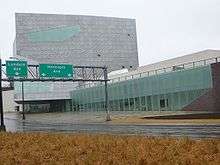
In the 20th century, the Twin Cities area expanded outward significantly. Automobiles made it possible for suburbs to grow greatly. The area now has a number of freeways to transport people by car. The area incorporates a large number of traffic cameras and ramp meters to monitor and manage traffic congestion. There is some use of HOV (high-occupancy vehicle) express lanes, which is becoming much more common. In order to use an express lane, a driver must have a MnPASS transponder or have at least one passenger. MnPASS rates are determined by the amount of traffic on the road and/or the time of day. During non-peak times, the MnPASS express lanes, with the exception of those on Interstate 394 (I-394) between Minnesota Highway 100 (MN 100) and I-94, are open to all traffic.
I-94 comes into the area from the east and heads northwest from Minneapolis. Two spur routes form the I-494/I-694 loop, and I-394 continues west when I-94 turns north. Additionally, I-35 splits in Burnsville in the southern part of the Twin Cities region, bringing I-35E into Saint Paul and I-35W into Minneapolis. They join together again to the north in Columbus, (just south of Forest Lake) and continue to the highway's terminus in Duluth. This is one of only two examples of an Interstate Highway splitting into branches and then rejoining into one again; the other split occurs in Dallas-Fort Worth, where I-35 also splits into east and west branches.
On August 1, 2007, a large portion of the I-35W Mississippi River bridge near University Avenue in the city of Minneapolis collapsed into the Mississippi River around 6:05pm CDT.[61][62] A replacement bridge opened on Thursday, September 18, 2008.
|
Interstates
|
U.S. Highways
|
Major state highways
|
|
Air travel
The main airport in the region is Minneapolis–Saint Paul International Airport (MSP), which is a major hub for Delta Air Lines. The airport is also the main hub and operating base for Sun Country Airlines. There are six smaller (relief) airports in the area which are owned and operated by the Metropolitan Airports Commission (the same agency operates the main MSP airport). Some people even commute by air to the Twin Cities from the northern part of the state.
|
Domestic-only carriers from MSP:
|
Domestic and international carriers from MSP:
Foreign-based international carriers from MSP:
|
Relief airports in the metropolitan area are:
|
|
|
Public transit
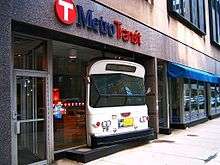
Metro Transit, by far the biggest bus service provider in the area, owes its existence to the old streetcar lines that ran in the area. Metro Transit provides about 95% of the public transit rides in the region with over 900 buses, although some suburbs have other bus services. The University of Minnesota, Twin Cities operates a free bus system between its campuses. This system includes the Campus Connector bus rapid transit line which travels between the Minneapolis and Saint Paul campuses by a dedicated bus line, and throughout the two campuses on normal access roads. The METRO Blue Line LRT (light rail) began operations in June 2004, connecting downtown Minneapolis, Minneapolis–Saint Paul International Airport and the Mall of America in Bloomington. It was followed by the METRO Red Line BRT (bus rapid transitway) in 2013 connecting the Mall of America with Lakeville along Cedar Avenue through the southern suburbs. The METRO Green Line LRT connecting downtown Minneapolis, the University of Minnesota campus and downtown Saint Paul along University Avenue opened in June 2014.[63] All three lines are operated by Metro Transit. Additionally, the Northstar Line commuter rail line connecting Minneapolis with Big Lake opened in November 2009; the line may be extended to St. Cloud as ridership numbers warrant.
In many ways the light rail of today is a return to the streetcars that existed in the past, it is being used as a stepping-stone to other projects.

A variety of rail services are currently being pondered by state and local governments, including neighborhood streetcar systems, intercity light rail service, and commuter rail options out to exurban regions. In addition, Minnesota is one of several states in the Midwest examining the idea of setting up high-speed rail service using Chicago as a regional hub.[64]
The Minneapolis–Saint Paul area has been criticized for inadequate public transportation.[65] Compared to many other cities its size, the public transportation system in the Minneapolis–Saint Paul area is less robust. As the metropolitan area has grown, the roads and highways have been updated and widened, but traffic volume is growing faster than the projects needed to widen them, and public transportation has not expanded enough to commensurate with the population. The Minneapolis–Saint Paul metropolitan area is ranked as the fifth worst for congestion growth of similar-sized U.S. metropolitan areas.[65] Additional lines and spurs are needed to upgrade public transportation in the Twin Cities.[66] Plans are underway for Green Line extension connecting downtown Minneapolis to the southwest suburb of Eden Prairie. A northwest LRT (Blue Line extension) along Bottineau Boulevard is being planned from downtown Minneapolis to Brooklyn Park. The METRO Orange Line BRT will open in 2021, connecting downtown Minneapolis with Lakeville to the south along I-35W. The METRO Gold Line BRT is planned to connect downtown Saint Paul to the eastern suburbs within the next few years.
Honors
The United States Navy currently has one ship named for the region, USS Minneapolis–Saint Paul, a Los Angeles-class submarine launched in 1983. Previously, two sets of two ships each had carried the names USS Minneapolis and USS Saint Paul.
References
- "Population and Housing Unit Estimates". Retrieved June 9, 2017.
- "U.S. Decennial Census". United States Census Bureau. Archived from the original on April 26, 2015. Retrieved October 15, 2014.
- "Historical Census Browser". University of Virginia Library. Retrieved October 15, 2014.
- "Population of Counties by Decennial Census: 1900 to 1990". United States Census Bureau. Retrieved October 15, 2014.
- "Census 2000 PHC-T-4. Ranking Tables for Counties: 1990 and 2000" (PDF). United States Census Bureau. Retrieved October 15, 2014.
- "Population of Counties by Decennial Census: 1900 to 1990". United States Census Bureau. Retrieved October 15, 2014.
- "Census 2000 PHC-T-4. Ranking Tables for Counties: 1990 and 2000" (PDF). United States Census Bureau. Retrieved October 15, 2014.
- Xiong, Yia. Minnesota cities.
- "St. Paul travel guide". Archived from the original on March 3, 2016. Retrieved February 6, 2016.
- Popik, Barry. "Barry Popik". www.barrypopik.com. Retrieved August 3, 2020.
- "The Expansionist Era (1805–1858)". Minnesota Historical Society. Retrieved May 2, 2019.
- "A History of Minneapolis". Minneapolis Public Library. 2001. Archived from the original on January 4, 2009. Retrieved May 2, 2019.
- "An Early History". Visit Saint Paul. Retrieved May 2, 2019.
- Robb, Edwin G. (1996). Afton Remembered. Afton Historical Society Press. ISBN 978-0-9639338-7-4.
- Orfield, Myron, Jr. (1997). "It Couldn't Happen Here...". Metropolitics : a regional agenda for community and stability. Washington DC: Brookings Institution. ISBN 0-8157-6640-8.
- Neset, Ray (July 20, 2007). "Plymouth Avenue 40 Years Later". Minneapolis Mirror. Archived from the original on January 9, 2009. Retrieved May 2, 2019.
- Abercrombie, Thomas J.; Griffiths, Annie (November 1980). "A Tale of Twin Cities, Minneapolis and St. Paul". National Geographic. Vol. 156 no. 5. pp. 664–691.
- Scheiber, Noam; Stockman, Farah; Goodman, J. David (June 6, 2020). "How Police Unions Became Such Powerful Opponents to Reform Efforts". The New York Times. ISSN 0362-4331. Retrieved June 7, 2020.
- Grim, Ryan; Chávez, Aída (June 2, 2020). "Minneapolis Police Union President: "I've Been Involved in Three Shootings Myself, and Not a One of Them Has Bothered Me"". The Intercept. Retrieved June 7, 2020.
- Navratil, Liz (June 5, 2020). "Minneapolis City Council to vote Friday on first changes to police". StarTribune. Retrieved June 7, 2020.
- Wingerd, Mary Lethert (February 2007). "Separated at Birth: The Sibling Rivalry of Minneapolis and St. Paul". OAH Newsletter. Organization of American Historians. Archived from the original on July 7, 2012.
- "Census-Bred Bitterness; St. Paul and Minneapolis Have Locked Horns". New York Times. June 21, 1890.
- "They Want Hay's Scalp.; St. Paul Residents Are Going to Descend Upon Washington". New York Times. June 22, 1890.
- "Fighting over the Census; St. Paul Jealous of Minneapolis and Charges Fraud". The New York Times. July 23, 1890.
- "May 10, 1965: Minneapolis falls an hour behind St. Paul". Star Tribune.
- "Minneapolis Minnesota". TrekkerTime.com. Retrieved May 7, 2007.
- "History of the NWS in the Twin Cities". National Weather Service. November 9, 2005. Retrieved May 7, 2007.
- Seeley, Mark W. (2006). Minnesota Weather Almanac. Minnesota Historical Society press. ISBN 0-87351-554-4.
- "Climatography of MSP". National Climatic Data Center. 1971–2000. Archived from the original on July 9, 2012.
- "Temperature Summary – 215435 MINNEAPOLIS WSFO AP, MN". Archived from the original on May 22, 2014.
- "Precipitation Summary – 215435 MINNEAPOLIS WSFO AP, MN". Archived from the original on May 19, 2014.
- "Snowfall Summary – 215435 MINNEAPOLIS WSFO AP, MN". Archived from the original on April 19, 2014.
- Scott, Woelm (June 30, 2006). "Top 10 Minnesota Severe Weather Events 1990–1999". Metro Skywarn. Archived from the original on March 28, 2007. Retrieved May 7, 2007.
- "Growing Season Summary – 215435 MINNEAPOLIS WSFO AP, MN". Archived from the original on July 9, 2013.
- "USNA – USDA Plant Hardiness Zone Map:North-Midwest US". Archived from the original on June 29, 2014. Retrieved May 19, 2014.
- Millett, Larry (1992). Lost Twin Cities. St. Paul, Minnesota: Minnesota Historical Society.
- Larson, Paul Clifford; Martin, Judith (1988). Larson, Paul Clifford (ed.). The Spirit of H.H. Richardson on the Midland Prairies. Ames, Iowa: Iowa State University Press.
- "Update of Statistical Area Definitions and Guidance on Their Uses" (PDF). Office of Management and Budget. November 20, 2008. Retrieved March 8, 2015.
- "Revised Delineations of Metropolitan Statistical Areas, Micropolitan Statistical Areas, and Combined Statistical Areas, and Guidance on Uses of the Delineations of These Areas" (PDF). Office of Management and Budget. February 28, 2013. Retrieved March 8, 2015.
- "Table 2. Annual Estimates of the Population of Combined Statistical Areas: April 1, 2010 to July 1, 2012". 2012 Population Estimates. United States Census Bureau, Population Division. March 2013. Archived from the original (CSV) on May 17, 2013. Retrieved April 19, 2013.
- 2018 population estimates released by the Metropolitan Council as of 4/1/2019
- "Our Estimates". MN State Demographic Center. Retrieved October 15, 2018.
- "How to fringe". Fresh Art Delivered Daily. Minnesota Fringe Festival. 2006. Archived from the original on November 14, 2006. Retrieved November 22, 2006.
- "Rock the Garden".
- "Basilica Block Party to rise again: Here's the '18 lineup".
- "Actively Moving America to Better Health" (PDF). American College of Sports Medicine. 2011. Archived from the original (PDF) on September 8, 2013. Retrieved May 23, 2011.
- "Health and Community Fitness Status of the 50 Largest Metropolitan Areas" (PDF). American College of Sports Medicine (ACSM) American Fitness Index. 2012. Archived from the original (PDF) on September 3, 2013. Retrieved June 29, 2012.
- Douglas, Phil; Blumer, Ward. "Minnesota Facts and Trivia". 50States.com. Retrieved December 16, 2018.
- "A Look Back". USA Water Ski & Wake Sports Foundation. Archived from the original on December 17, 2018. Retrieved December 16, 2018.
1922: Ralph Samuelson designed the first water skis from two pine boards and successfully skied on Lake Pepin in Lake City, MN.
- "A History of Minneapolis: Radio and Television". Minneapolis Public Library. 2001. Archived from the original on April 19, 2007. Retrieved May 10, 2007.
- "Nielsen Audio Ratings". Radio, Online. 2018. Retrieved December 18, 2018.
- "Forum: Top 20 US Radio Markets". Retrieved December 16, 2018.
- "#15 Minneapolis-St. Paul November 2018 Portable People Meter Ratings". November 29, 2018. Retrieved December 16, 2018.
- "HD Radio – Minnesota". iBiquity. 2007. Archived from the original on September 27, 2007. and "Independent Public Radio". 2006. Archived from the original on June 29, 2007. Retrieved May 10, 2007.
- "Garrison Keillor Hosts Final A Prairie Home Companion Episode". The Guardian. July 2, 2016. Retrieved December 16, 2018.
- Welcome to Paganistan
- Wiccan prisoner sues state, claiming religious rights violated
- "Gross Domestic Product by Metropolitan Area, 2015". Retrieved July 7, 2016.
- "Analysis by Crossborder Group Finds Tijuana #1 City in North America for Medical Device Manufacturing Employment". Tijuana Economic Development Corporation. Retrieved August 14, 2011.
- Roberts, Deon; Rothacker, Rick (May 24, 2017). "Goodbye bragging rights: Charlotte's no longer the No. 2 U.S. banking center". Charlotte Observer. Retrieved July 6, 2017.
- "35W bridge collapses over Mississippi River, cars in the water". St. Paul Pioneer Press. August 1, 2007. Retrieved August 1, 2007.
- "35W bridge over Mississippi collapsed". St. Paul: KSTP-TV. August 1, 2007. Archived from the original on October 16, 2015. Retrieved August 1, 2007.
- "Metropolitan Council – Central Corridor transit FAQ". Archived from the original on June 12, 2011. Retrieved July 3, 2011.
- Midwest Regional Rail Initiative. Retrieved June 24, 2008.
- Metropolitan Council Release on Traffic Congestion. Retrieved October 16, 2006. Archived February 21, 2012, at the Wayback Machine
- "Metropolitan Council – Central Corridor transit FAQ". Archived from the original on June 12, 2011. Retrieved July 3, 2011.
External links
| Wikivoyage has a travel guide for Minneapolis-Saint Paul. |
- Flyby video courtesy NASA/Goddard Scientific Visualization Studio
- Fact sheet about Minneapolis–St. Paul Metropolitan Area Comparison
- History of the National Weather Service in Minneapolis–St. Paul, Minnesota
- GIS-based Demographic Guide to Twin Cities Region
- Lost Twin Cities – Documentary produced by Twin Cities Public Television
.jpg)
